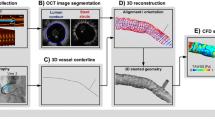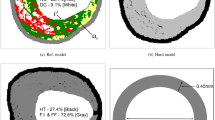Abstract
Machine learning (ML) techniques have shown great potential in cardiovascular surgery, including real-time stenosis recognition, detection of stented coronary anomalies, and prediction of in-stent restenosis (ISR). However, estimating neointima evolution poses challenges for ML models due to limitations in manual measurements, variations in image quality, low data availability, and the difficulty of acquiring biological quantities. An effective in silico model is necessary to accurately capture the mechanisms leading to neointimal hyperplasia. Physics-informed neural networks (PINNs), a novel deep learning (DL) method, have emerged as a promising approach that integrates physical laws and measurements into modeling. PINNs have demonstrated success in solving partial differential equations (PDEs) and have been applied in various biological systems. This paper aims to develop a robust multiphysics surrogate model for ISR estimation using the physics-informed DL approach, incorporating biological constraints and drug elution effects. The model seeks to enhance prediction accuracy, provide insights into disease progression factors, and promote ISR diagnosis and treatment planning. A set of coupled advection-reaction-diffusion type PDEs is constructed to track the evolution of the influential factors associated with ISR, such as platelet-derived growth factor (PDGF), the transforming growth factor-\(\beta\) (TGF-\(\beta\)), the extracellular matrix (ECM), the density of smooth muscle cells (SMC), and the drug concentration. The nature of PINNs allows for the integration of patient-specific data (procedure-related, clinical and genetic, etc.) into the model, improving prediction accuracy and assisting in the optimization of stent implantation parameters to mitigate risks. This research addresses the existing gap in predictive models for ISR using DL and holds the potential to enhance patient outcomes through predictive risk assessment.











Similar content being viewed by others
References
Barilli A, Visigalli R, Sala R, Gazzola GC, Parolari A, Tremoli E, Bonomini S, Simon A, Closs EI, Dall’Asta V, Bussolati O (2008) In human endothelial cells rapamycin causes mtorc2 inhibition and impairs cell viability and function. Cardiovasc Res 78(3):563–571. https://doi.org/10.1093/cvr/cvn024
Barlis P, Regar E, Serruys PW, Dimopoulos K, van der Giessen WJ, van Geuns R-JM, Ferrante G, Wandel S, Windecker S, van Es G-A, Eerdmans P, Jüni P, di Mario C (2010) An optical coherence tomography study of a biodegradable vs. durable polymer-coated limus-eluting stent: a leaders trial sub-study. Eur Heart J 31(2):165–176. https://doi.org/10.1093/eurheartj/ehp480
Baydin AG, Pearlmutter BA, Radul AA, Siskind JM (2018) Automatic differentiation in machine learning: a survey. J Mach Learn Res 18(1):5595–5637
Caiazzo A, Evans D, Falcone J-L, Hegewald J, Lorenz E, Stahl B, Wang D, Bernsdorf J, Chopard B, Gunn J, Hose R, Krafczyk M, Lawford P, Smallwood R, Walker D, Hoekstra A (2011) A complex automata approach for in-stent restenosis: two-dimensional multiscale modelling and simulations. J Computat Sci 2(1):9–17. https://doi.org/10.1016/j.jocs.2010.09.002
Ciompi F, Balocco S, Rigla J, Carrillo X, Mauri J, Radeva P (2016) Computer-aided detection of intracoronary stent in intravascular ultrasound sequences. Med Phys 43(10):5616–5625. https://doi.org/10.1118/1.4962927
Danilov VV, Klyshnikov KY, Gerget OM, Kutikhin AG, Ganyukov VI, Frangi AF, Ovcharenko EA (2021) Real-time coronary artery stenosis detection based on modern neural networks. Sci Rep 11:7582. https://doi.org/10.1038/s41598-021-87174-2
Escuer J, Martínez MA, McGinty S, Peña E (2019) Mathematical modelling of the restenosis process after stent implantation. J R Soc Interface 16:20190313. https://doi.org/10.1098/rsif.2019.0313
Evans D, Lawford P, Gunn J, Walker D, Hose D, Smallwood R, Chopard B, Krafczyk M, Bernsdorf J, Hoekstra A (2008) The application of multiscale modelling to the process of development and prevention of stenosis in a stented coronary artery. Philoso Trans R Soc A Math Phys Eng Sci 366(1879):3343–3360. https://doi.org/10.1098/rsta.2008.0081
Fattori R, Piva T (2003) Drug-eluting stents in vascular intervention. Lancet 361(9353):247–249. https://doi.org/10.1016/S0140-6736(03)12275-1
Gautam N, Saluja P, Malkawi A, Rabbat MG, Al-Mallah MH, Pontone G, Zhang Y, Lee BC, Al’Aref SJ (2022) Current and future applications of artificial intelligence in coronary artery disease. Healthcare 10(2):232. https://doi.org/10.3390/healthcare10020232
Gierig M, Wriggers P, Marino M (2023) Arterial tissues and their inflammatory response to collagen damage: a continuum in silico model coupling nonlinear mechanics, molecular pathways, and cell behavior. Comput Biol Med 158:106811. https://doi.org/10.1016/j.compbiomed.2023.106811
Güldener U, Kessler T, von Scheidt M, Hawe JS, Gerhard B, Maier D, Lachmann M, Laugwitz K-L, Cassese S, Schömig AW, Kastrati A, Schunkert H (2023) Machine learning identifies new predictors on restenosis risk after coronary artery stenting in 10,004 patients with surveillance angiography. J Clin Med 12(8):2941. https://doi.org/10.3390/jcm12082941
Haghighat E, Raissi M, Moure A, Gomez H, Juanes R (2021) A physics-informed deep learning framework for inversion and surrogate modeling in solid mechanics. Comput Methods Appl Mech Eng 379:113741. https://doi.org/10.1016/j.cma.2021.113741
Jukema JW, Verschuren JJW, Ahmed TAN, Quax PHA (2012) Restenosis after pci. part 1: pathophysiology and risk factors. Nat Rev Cardiol 9(1):53–62. https://doi.org/10.1038/nrcardio.2011.132
Keshavarzian M, Meyer CA (2018) Heather, mechanobiological model of arterial growth and remodeling. Biomech Model Mechanobiol 17(1):87–101. https://doi.org/10.1007/s10237-017-0946-y
Kim MS, Dean LS (2011) In-stent restenosis. Cardiovasc Ther 29(3):190–198. https://doi.org/10.1111/j.1755-5922.2010.00155.x
Kissas G, Yang Y, Hwuang E, Witschey WR, Detre JA, Perdikaris P (2020) Machine learning in cardiovascular flows modeling: predicting arterial blood pressure from non-invasive 4d flow MRI data using physics-informed neural networks. Comput Methods Appl Mech Engineering 358:112623. https://doi.org/10.1016/j.cma.2019.112623
Li S, Lei L, Hu Y, Zhang Y, Zhao S, Zhang J (2019) A fully coupled framework for in silico investigation of in-stent restenosis. Comput Methods Biomech Biomed Eng 22(2):217–228. https://doi.org/10.1080/10255842.2018.1545017
Liistro F, Stankovic G, Mario CD, Takagi T, Chieffo A, Moshiri S, Montorfano M, Carlino M, Briguori C, Pagnotta P, Albiero R, Corvaja N, Colombo A (2002) First clinical experience with a paclitaxel derivate-eluting polymer stent system implantation for in-stent restenosis. Circulation 105(16):1883–1886. https://doi.org/10.1161/01.CIR.0000016042.69606.61
Liu M, Liang L, Sun W (2020) A generic physics-informed neural network-based constitutive model for soft biological tissues. Comput Methods Appl Mech Eng 372:113402. https://doi.org/10.1016/j.cma.2020.113402
Liu M, Liang L, Dong H, Sun W, Gleason RL (2022) Constructing growth evolution laws of arteries via reinforcement learning. J Mech Phys Solids 168:105044. https://doi.org/10.1016/j.jmps.2022.105044
Lu L, Meng X, Mao Z, Karniadakis GE (2021) Deepxde: a deep learning library for solving differential equations. SIAM Rev 63(1):208–228. https://doi.org/10.1137/19M1274067
Manjunatha K, Behr M, Vogt F, Reese S (2022) A multiphysics modeling approach for in-stent restenosis: theoretical aspects and finite element implementation. Comput Biol Med 150:106166. https://doi.org/10.1016/j.compbiomed.2022.106166
Manjunatha K, Schaaps N, Behr M, Vogt F, Reese S (2023) Computational modeling of in-stent restenosis: pharmacokinetic and pharmacodynamic evaluation. Comput Biol Med 167:107686. https://doi.org/10.1016/j.compbiomed.2023.107686
Nolan DR, Lally C (2018) An investigation of damage mechanisms in mechanobiological models of in-stent restenosis. J Comput Sci 24:132–142. https://doi.org/10.1016/j.jocs.2017.04.009
Park D-W, Hong M-K, Mintz GS, Lee CW, Song J-M, Han K-H, Kang D-H, Cheong S-S, Song J-K, Kim J-J, Weissman NJ, Park S-W, Park S-J (2006) Two-year follow-up of the quantitative angiographic and volumetric intravascular ultrasound analysis after nonpolymeric paclitaxel-eluting stent implantation: late “catch-up” phenomenon from aspect study. J Am Coll Cardiol 48(12):2432–2439
Raissi M, Perdikaris P, Karniadakis G (2019) Physics-informed neural networks: a deep learning framework for solving forward and inverse problems involving nonlinear partial differential equations. J Comput Phys 378:686–707. https://doi.org/10.1016/j.jcp.2018.10.045
Reese S, Manjunatha K, Shi J, Sesa M (2023) Deep learning-based surrogate modeling of coronary in-stent restenosis. In: Conference: 10th edition of the international conference on computational methods for coupled problems in science and engineering https://doi.org/10.23967/c.coupled.2023.023
Sahli Costabal F, Yang Y, Perdikaris P, Hurtado DE, Kuhl E (2020) Physics-informed neural networks for cardiac activation mapping. Front Phys 8:42. https://doi.org/10.3389/fphy.2020.00042
Sampedro-Gómez J, Dorado-Díaz PI, Vicente-Palacios V, Sánchez-Puente A, Jiménez-Navarro M, San-Roman JA, Galindo-Villardón P, Sanchez PL, Fernández-Avilés F (2020) Machine learning to predict stent restenosis based on daily demographic, clinical, and angiographic characteristics. Can J Cardiol 36(10):1624–1632. https://doi.org/10.1016/j.cjca.2020.01.027
Shi J, Manjunatha K, Reese S (2023) Multiphysical modeling of soft tissue-stent interaction. Proc Appl Math Mech. https://doi.org/10.1002/pamm.202300090
Su B, Zhang J-M, Zou H, Ghista D, Le TT, Chin C (2020) Generating wall shear stress for coronary artery in real-time using neural networks: feasibility and initial results based on idealized models. Comput Biol Med 126:104038. https://doi.org/10.1016/j.compbiomed.2020.104038
Wang H et al (2016) Global, regional, and national life expectancy, all-cause mortality, and cause-specific mortality for 249 causes of death, 1980–2015: a systematic analysis for the global burden of disease study 2015. Lancet 388(10053):1459–1544. https://doi.org/10.1016/S0140-6736(16)31012-1
Xu C, Yi Y, Xu M, Yan J, Guo Y-B, Wang J, Wang Y, Li Y-M, Jin Z-Y, Wang Y-N (2023) Coronary artery stent evaluation by CTA: Impact of deep learning reconstruction and subtraction technique. Am J Roentgenol 220(1):63–72. https://doi.org/10.2214/AJR.22.27983
Zahedmanesh H, Oosterwyck HV, Lally C (2014) A multi-scale mechanobiological model of in-stent restenosis: deciphering the role of matrix metalloproteinase and extracellular matrix changes. Comput Methods Biomech Biomed Eng 17(8):813–828. https://doi.org/10.1080/10255842.2012.716830
Acknowledgements
Financial support provided by the German Research Foundation (DFG) for the subproject “In-stent restenosis in coronary arteries - in silico investigations based on patient-specific data and meta modeling” (project number 465213526) of SPP2311 is gratefully acknowledged. In addition, we acknowledge the financial support from DFG through projects 395712048 and 403471716. Jianye Shi would like to extend his appreciation for the computational resource provided by the RWTH GPU Cluster.
Funding
Deutsche Forschungsgemeinschaft 395712048 and 403471716
Author information
Authors and Affiliations
Contributions
JS contributed to conceptualization, investigation, data curation, modeling, and writing—original draft. KM contributed to conceptualization, methodology, and review. MB performed investigation, methodology, and review. FVogt done review & editing. SR conttributed to supervision and review.
Corresponding author
Ethics declarations
Conflict of interest
The authors declare that they have no known competing financial interests or personal relationships that could have appeared to influence the work reported in this paper.
Rights and permissions
Springer Nature or its licensor (e.g. a society or other partner) holds exclusive rights to this article under a publishing agreement with the author(s) or other rightsholder(s); author self-archiving of the accepted manuscript version of this article is solely governed by the terms of such publishing agreement and applicable law.
About this article
Cite this article
Shi, J., Manjunatha, K., Behr, M. et al. A physics-informed deep learning framework for modeling of coronary in-stent restenosis. Biomech Model Mechanobiol 23, 615–629 (2024). https://doi.org/10.1007/s10237-023-01796-1
Received:
Accepted:
Published:
Issue Date:
DOI: https://doi.org/10.1007/s10237-023-01796-1




